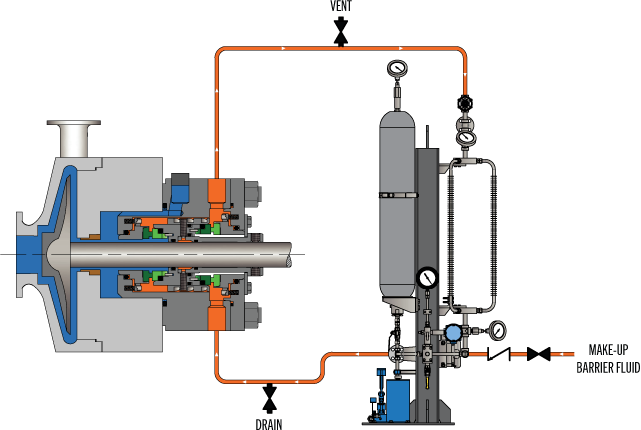External barrier liquid system pressurized by a bladder accumulator supplying clean fluid to the inboard and outboard seal faces.

Description
Plan 53B requires the use of an extraneous barrier fluid system pressurized by a bladder accumulator delivering clean fluid to the seal faces.
Application Notes
- Used with Arrangement 3 seals.
- For use in applications where direct gas pressurization, such as in Plan 53A, would risk absorption of the gas into the barrier liquid.
- Accumulator and barrier liquid are maintained at a pressure greater than the seal chamber pressure. It is recommended that the barrier fluid pressure always exceeds the maximum seal chamber pressure by at least 20 psi [1.4 bar].
- Barrier liquid is circulated through the fluid circuit by means of an internal circulating device (pumping ring).
- Venting of the system during commissioning to eliminate all gas and air bubbles from the system is crucial to proper operation. Vent should be closed when pressurizing and during normal pump operation.
- The use of a bladder accumulator prevents contact between the pressurization gas and the barrier liquid. This prevents gas absorption into the barrier liquid and allows for high-pressure operation.
- Process fluid never leaks to the atmosphere unless system pressure is lost.
- Seal performance is monitored by pressure level. Changes in pressure indicate potential leaks at either the inboard or outboard seal faces.
- Heat is removed using a heat exchanger.
- Barrier liquid must be compatible with the process liquid because it will leak into the product.
- System is sensitive to environmental heat loads which may cause significant fluctuations of the system pressure.
- Best piping practices must be followed to avoid vapor entrapment and stalled flow in the tubing.
Pros:
- Bladder accumulator keeps pressurized gas and barrier liquids from meeting each other
- No risk of process fluid leakage
- Heat exchanger maintains optimal process temperatures
Cons:
- Regular maintenance is required
- Requires strict adherence to best piping practices
- Barrier fluid and process fluids must be compatible due to the possibility of mixing
